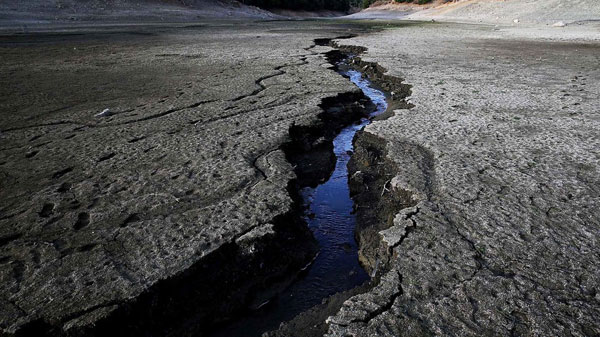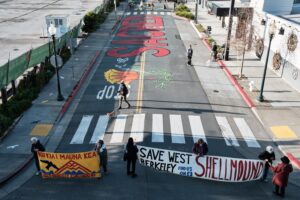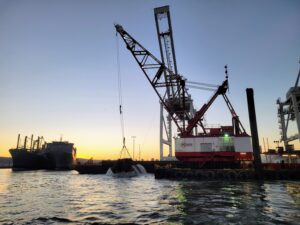
In these days of scarce water, the supply of organizations talking about water policy seems to exceed the supply of the precious liquid itself. But alongside the economically powerful giants duking it out for their share of the dwindling supplies, there’s The Environmental Justice Coalition for Water (EJCW), which focuses on the inequitable allocation of water to low-income communities and urges legislative reform. I recently spoke with Colin Bailey, a Bay Area native who is now executive director of EJCW, to find out what got him involved in the contentious world of California water policy.
BN: Are you originally from the Bay Area?
Bailey: Yes, I grew up in Mountain View. I’ve lived in California all my life. I love California’s diversity in every respect. Ecologically, there are mountains, deserts, coastal zones, and bay wetlands (which I grew up next to). I also value the social diversity of the state.
BN: What kinds of experiences did you have early on that led you to this kind of work?
Bailey: My father is an environmental activist. There’s a funny picture of me in 1983 sitting on top of a pile of cans we’d collected to demonstrate the benefits of the Bottle Bill (California’s beverage container deposit law). I also grew up in the Episcopal Church, which presented a lot of moral teachings that supported social justice and environmentalism.
BN: Where did you go to college and what did you study?
I was an undergraduate at UC Berkeley where I earned a BA in anthropology in 1999. I studied with Laura Nader, who was the most righteous person I’ve ever met. She taught that law can be an instrument for social change. I also studied Environmental Science Policy and Management with Claudia Carr. She taught the class on Natural Resource Management and Indigenous People’s rights that really changed my worldview and helped me develop a sense of global environmental justice through learning about the experiences of indigenous people.
BN: Then did you go to law school?
Bailey: Yes, I went to UCLA School of Law , where I got a law degree and certifications in Public Interest and Public Policy Law and Critical Race Studies. Two years after graduating, I went to work for a cutting-edge legal aid organization in Sacramento — Legal Services of Northern California. In my second year out of law school I became lead counsel for a case in which a relatively small local community took on and defeated a large utility. Sacramento Natural Gas Storage was prevented from storing a huge quantity of gas underground in a South Sacramento neighborhood. That case ran for five and a half years and it was the first of its kind. A documentary about it will be coming out soon.
BN: What’s the goal of your work at EJCW?
Bailey: Our vision is that all communities throughout California should have access to safe, clean and affordable water for personal, cultural and recreational usage.
BN: Recreational usage? Isn’t this goal at odds with the others? Do you mean that everyone should be able to go jet skiing?
Bailey: No, of course not. There’s an environmental ethic that runs through this work. If a situation arose where a recreational use caused environmental damage, we would not pursue the recreational focus.
BN: What is your most recent success?
Bailey: The signing of the Human Right to Water bill in September 2012 by Governor Brown; it says every human has the right to safe, clean, and affordable water.
BN: How can every person have access to clean and affordable water during a period of drought if there just isn’t enough water?
Bailey: Legislation can’t have a bearing on Mother Nature. However, even in a drought, there’s enough water to meet basic needs. The Human Right to Water bill speaks to those basic needs.
BN: What challenges do you face in this work?
Bailey: The systems that have traditionally left the powerful entrenched interests in charge of where water goes. The drought hasn’t helped, although it has raised the consciousness of people about water policy and the importance of water.
BN: Given the current drought situation, what is the most pressing issue you’re working on these days?
As California endures a drought, the severity of which is unprecedented in modern times, we are working to ensure that the basic needs of California’s most vulnerable communities — typically those served by small water systems and private wells — for safe, clean, accessible, and affordable water are met by the flurry of emergency funding and other water-related bills. These efforts include implementing California’s human right to water policy, Water Code section 106.3 (AB 685), through funding guidelines and other state agency actions.
However, the drought and the seemingly credible predictions that this is our new climatic reality have made us realize there is an immediate need for long-term planning. Our water governance system has been incoherent and inequitable for too long and the consequences of both shortcomings are being borne, first and worst, by California’s most vulnerable communities.
BN: With water supplies running low in agricultural areas and fields lying fallow, how are you helping the immigrants who normally work in these fields get the water they need to survive?
We continue to receive calls from community members whose wells are running dry, most of them in agricultural areas. Among other strategies, we are working with the State Water Board to exercise its authority to require polluters to provide replacement water to the many communities that cannot drink the water coming out of their tap because of the high level of contamination. Unfortunately, this is not enough, so the ability to access safe, clean, and affordable water will depend, in large part, on assistance from the state and federal government.
BN: What is your favorite outdoor location in the Bay Area?
Bailey: Deer Hollow Farm and the preserve that it’s a part of, Rancho San Antonio, just outside Cupertino. The preserve has a vast expanse of trees and trails. As a kid I went to a camp at Deer Hollow and learned about animal husbandry. Then when I was in high school, we would go running at the preserve four or five times a week. And we saw some extraordinary things. One time I was running and I had to leap right over a three-and-a-half-foot-long rattlesnake. Another time, we came around a sharp bend and there was a mule deer buck. We startled him, then he and we ran off in opposite directions. There were also feral pigs and even bobcats.





